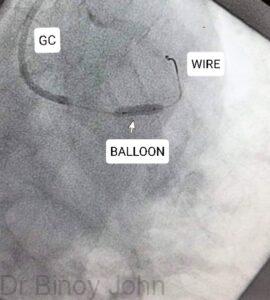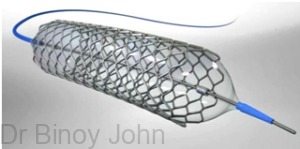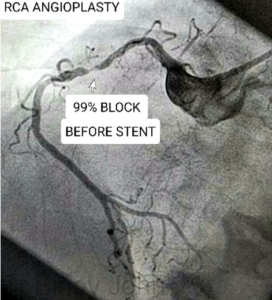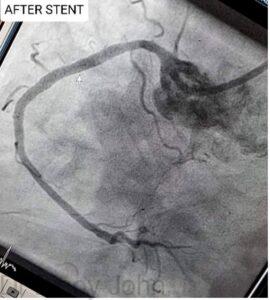What is a Multi-vessel angioplasty?
When angioplasty is performed in a single artery it is called ‘Single’ vessel angioplasty and when it is performed in more than one coronary artery it is called Multi vessel angioplasty. The procedure in a ‘Multi’-vessel angioplasty is the same as for a single vessel angioplasty. (See section on: Coronary angioplasty)
Initially, angioplasty and stenting of one artery is performed, followed by angioplasty and stenting of the next artery and then of the third. Shown below is a Multi-vessel angioplasty performed in both the left anterior descending (LAD) artery and the right coronary (RCA) artery in a 71 years old patient. (See pictures of LAD and RCA angioplasty below).
In a coronary angioplasty, a catheter or tube, called guiding catheter is placed in the mouth of the coronary artery in which angioplasty has to be performed. The diameter of this catheter is larger than the diameter of the catheter used to perform a coronary angiogram. Initially a coronary angiogram is performed with the guiding catheter. This angiogram helps to identify and profile the block. (See image) The image shows a 99% block in the LAD artery.

Once the block is identified, a wire is passed through the catheter to cross the block. Thereafter, a balloon is taken over the wire and placed across the block. The balloon is then inflated from outside with an instrument called an in-deflator to open the block. (See image)

The balloon is then removed and then a stent is tracked on the wire and is positioned across the block (See image)

The stent is a tubular mesh, often coated with a medication, called a Drug coated stent, comes pre-mounted on a balloon. When the balloon is inflated the stent gets apposed to the wall of the artery. (See image)

After the stent is deployed, the stent balloon is deflated and removed. Often, a larger balloon is often used to make the stent larger and to get the stent better apposed to the arterial wall. Then the final angiogram is done to check the final result and presence of good blood flow and absence of complications. (See image) The image shows a well apposed stent with good flow in the LAD artery. See before stent image to appreciate the difference.

Once the angioplasty of the first artery is completed, angioplasty of the second artery is completed and the third artery subsequently, if needed. Below are images of a Multi-vessel angioplasty of RCA after the LAD angioplasty was completed. (See images)
The angiogram performed shows a RCA 99% block. (See Image)

Then a wire is placed across the block, deep in the RCA and then a balloon is advanced on the wire and positioned across the block and inflated to open the block. (See image)

Then the stent is positioned across the block. (See Image)

And then the stent is deployed and thereafter a final angiogram is done to check the final result and blood flow. (See image). The image shows an excellent result with good blood flow in the RCA. See the initial image of the 99% block to appreciate the difference.

Finally, a few hours after completion of angioplasty of all the arteries, the sheath or tube on the hand or leg, through which the angioplasty was performed is removed. Usually the patient is discharged after 24 to 48 hours, depending on the complexity of the procedure and the course in the hospital, after an over-night observation in the coronary care unit. It is always safer for the patient to be in-hospital for at least 36 hours after the procedure.
Expertise: Dr Binoy John is an expert in performance of multi vessel and multi-stent angioplasties.
Video: A multi vessel angioplasty with four stents in the Left main artery, LAD artery and Left Circumflex artery, in a patient with Stage 5 kidney failure:






